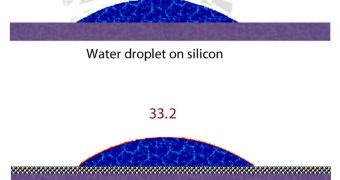A new study conducted by experts at the Rice University and the Rensselaer Polytechnic Institute (RPI) determined that materials coated with a layer of the 2D carbon compound graphene remain wettable.
This is a very important finding, because it suggests that the single-atom-thick material is largely invisible to water. At the same time, graphene is largely transparent in optical wavelengths as well, so this discovery opens up a host of new, potential applications for this carbon compound.
Scientists say that numerous materials can be enhanced with graphene in a large number of ways. For instance, the compound can be used as reinforcement, since it's the toughest material known to man. It can also be used to give the surface of other materials the ability to conduct electricity.
The amazing new property researchers found in graphene was proven to be applicable to some of the most important chemicals used in all industries today, such as gold, copper and silicon. Water “sticks” to these elements just as readily as it would if they weren't covered with the carbon compound.
Experts at RPI and Rice say that the new study could be used to lay the foundation for developing methods of producing fine-tune surface coatings, fit for a vast number of practical applications. The research is also useful because graphene is bound to replace silicon in electronics very soon.
Details of the new study and the methodology the team used to conduct it appear in the latest online issue of the top scientific journal Nature Materials. “The extreme thinness of graphene makes it a totally non-invasive coating,” researcher Pulickel Ajayan explains.
“A drop of water sitting on a surface 'sees through' the graphene layers and conforms to the wetting forces dictated by the surface beneath. It's quite an interesting phenomenon unseen in any other coatings and once again proves that graphene is really unique in many different ways,” he adds.
The expert is the Rice Benjamin M. and Mary Greenwood Anderson Professor in Mechanical Engineering and Materials Science, and also a professor of chemistry at the university. He led the work with RPI professor of mechanical, aerospace and nuclear engineering, Nikhil Koratkar.
“Graphene could be one of a kind as a coating, allowing the intrinsic physical nature of surfaces, such as wetting and optical properties, to be retained while altering other specific functionalities like conductivity,” Ajayan explains.
A potential application that springs to mind immediately is the development of conductive and impermeable surface coatings. Such materials are exceedingly rare, and difficult to produce.
This study was sponsored by the US National Science Foundation (NSF), the Advanced Energy Consortium, and the MURI program at the Office of Naval Research.

 14 DAY TRIAL //
14 DAY TRIAL //